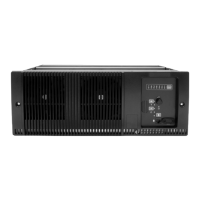TB9100/P25 CG/P25 TAG Installation and Operation Manual Installation 55
© Tait Limited March 2014
If you don’t have a test set, use a signal generator, and monitor the RSSI
voltage on the rear D-range (pin 9: the output must be configured to
provide the RSSI).
2. Fully unmute the front panel speaker (two presses of the speaker
button).
3. Connect a SINAD meter (audio frequency input on the test set) to
the analog line output.
4. If the receiver is UHF, adjust the front-end helical filters.
a. Insert the Johanson tuning tool into the first hole of the first
(horizontal) set. You can start with the hole on the left side and
proceed along to the hole on the right, or vice versa. On K-band
reciters, the third hole tends to tune with the slug well out of the
filter body. Be careful not to unscrew the slug completely.
b. Tune each of the resonators in the first set once to give the best
signal (by ear using the speaker audio and/or by the SINAD
meter), reducing the RF input as required to give about a 12dB
SINAD. If RSSI is used, tune for maximum RSSI.
c. Insert the Johanson tuning tool into the first hole of the second
(vertical) set. You can start with the top hole and proceed down
to the bottom hole, or vice versa. (For digital board hardware ver-
sion 00.04 or earlier H-band reciters, use the Murata tuning tool
on this set instead.)
d. Tune each of the resonators in the second set once to give the best
response, reducing the RF level as above.
e. Repeat this procedure as necessary to refine the response.
First set
Second set
Helical filters:

